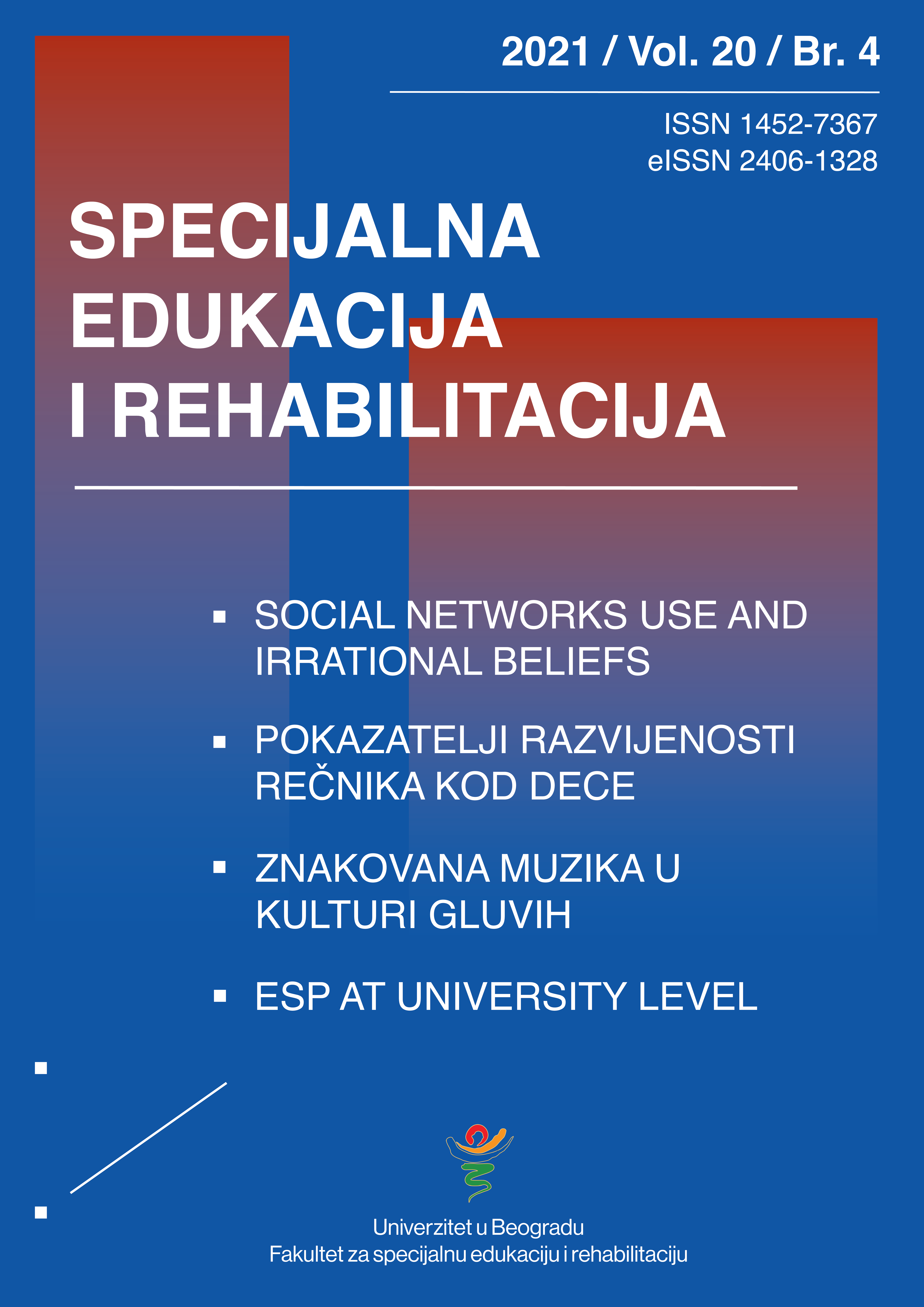Fenomen znakovane muzike u kulturi Gluvih
Sažetak
Uvod. Muzika u zajednici Gluvih je sociokulturni fenomen koji oslikava specifičan identitet i način doživljavanja sveta, koji je jednako raznovrstan, bogat i sadržajan kao i kod pripadnika bilo koje druge kulture. Cilj. Cilj ovog rada je da ukaže na istorijske i sociokulturne okvire, složenost, bogatstvo, specifične elemente, vrste i oblike muzičkog izražavanja pripadnika zajednice Gluvih. Metode. Primenjene metode su uporedna analiza, evaluacija i sistem dedukcije i indukcije. Rezultati. Zbog ograničenja ili nedostatka auditivne komponente pripadnici kulture Gluvih koriste različite komunikacione alate, poput govora, pantomime, izraza lica i znakovnog jezika. Znakovana muzika kao fenomen je umetnička forma koja nema dugu istoriju, ali od devedesetih godina prošlog veka i sa tehnološkim razvojem zadobija sve veće interesovanje i priznanje u zajednici Gluvih i među „slušateljima”. Znakovana muzika koristi specifične vizuo-prostorno-kinestetičke i auditivne elemente u izražavanju, poput ritma, dinamike, rime, izražajnosti, ikoničnosti, intenziteta muzičke percepcije i kombinacije uloge izvođača. Zaključak. Znakovana muzika kao fenomen je umetnička forma koja inkorporira znakovane poetske karakteristike (lirske sadržaje), vizuelne muzičke elemente i ples.
Reference
Akmajian, A., Demers, R. A., Farmer, A. K., & Harnish, R. M. (2010). Linguistics: An introduction to language and communication (6th ed.). MIT Press.
Bahan, B. (2006). Face-to-face tradition in the American Deaf community: Dynamics of the teller, the tale, and the audience. In H-D. L. Bauman, J. L. Nelson, & H. M. Rose (Eds.), Signing the body poetic: Essays on American Sign Language literature (pp. 21-50). University of California Press.
Baldwin, S. C. (1993). Pictures in the air: The story of the National Theatre of the Deaf. Gallaudet University Press.
Bauman, D-H. L. (2006). Getting out of line: Toward a visual and cinematic poetics of ASL. In H-D. L. Bauman, J. L. Nelsen, & H. M. Rose (Ed.), Signing the body poetic: Essays on American sign language literature (pp. 95-117). University of California Press.
Best, K. E. (2015/2016). We still have a dream: The Deaf hip hop movement and the struggle against the socio-cultural marginalization of Deaf people. Lied und popülare Kulture / Song and Popular Culture, 60/61, 61-86.
Best, K. E. (2018). Musical belonging in a hearing-centric society: Adapting and contesting dominant cultural norms through Deaf hip hop. Journal of American Sign Languages and Literature. http://journalofasl.com/wp-content/uploads/sites/8/2018/06/best.pdf
Caldas, A. L. P. (2012). A língua de sinais e os sons: uma apreciação estética [Sign language and sounds: An aesthetic appreciation]. In E. Beyer, & P. Kebach (Eds.), Pedagogia da música: experiências de apreciação musical [Music pedagogy: Music appreciation experiences] (2nd ed.). Mediação.
Canadian Cultural Society of the Deaf. (2015). Deaf arts handbook series: Vol. 2. Signed Music: Rhythm of the Heart.
Caswell, E. (2017, March 27). How sign language innovators are bringing music to the deaf [Video]. YouTube. https://www.youtube.com/watch?v=EuD2iNVMS_4
Cripps, J. (2018). Ethnomusicology & signed music: A breakthrough. Journal of American Sign Languages and Literature. http://journalofasl.com/wp-content/uploads/sites/8/2018/08/ethnomusicology_cripps.pdf
Cripps, J. H., Small, A., Rosenblum, E., Supalla, S. J., Whyte, A. K., & Cripps, J. S. (in press). Signed music and the Deaf community. In A. Cruz (Ed.), Culture, deafness & music: Disability studies and a path to social justice. Sense Publishers.
Cripps, J., Rosenblum, E., & Small, A. (2019). Signed music: An emerging inter-performative art. In B. K. Eldredge, D. Stringham, & B. Jarashow (Eds.), Waypoint: Proceedings of the Sixth Biennial Deaf Studies Today! Deaf Studies Today!
Duarte, E. G. (2017). Uma ferramenta para a educação musical dos surdos [A tool for the musical education of deaf people] [Doctoral dissertation, Universidade Estadual de Campinas]. Red De Repositorios Latinoamericanos. http://repositorioslatinoamericanos.uchile.cl/handle/2250/1368668
Isaković, S. (2013). Umetnička muzika u virtuelnom svetu multimedije. Časopis za upravljanje komuniciranjem, 27, 51-66. https://doi.org/10.5937/comman1327049I
Johnston, R., & E., Erting, C. (1989). Ethnicity and socialization in a classroom for deaf children. In C. Lucas, & C. Valli (Eds.), Sociolinguistics of the deaf community (pp. 41-83). Academic Press.
Krstić, B., i Bistrik Orkestar. (2019). Smilj Smiljana [Pesma]. Na Svod. Hi-fi Music. https://www.youtube.com/watch?v=q4PXJehkl5U
Listman, J., Summer C. L., & Rosa L. T. (2018). Deaf musicality and unearthing the translation process. Journal of American Sign Languages and Literature. http://journalofasl.com/wp-content/uploads/sites/8/2018/08/deaf-musicality.pdf
Maler, A. (2015). Musical expression among Deaf and hearing song signers. In B. Howe, S. Jensen-Moulton, N. Neil Lerner, & J. Straus (Eds.), The Oxford handbook of music and disability studies (pp. 73-91). Oxford University Press.
Marijan, M. (2019). Sociokulturološki kontekst muzike. Accelerando: Belgrade Journal of Music and Dance, (4). https://accelerandobjmd.weebly.com/issue4/musical-framework-a-sociocultural-approach
McLuhan, M. (2001). Understanding media. Routledge.
Peters, K., & Seier. A. (2009). Home dance: Mediacy and aesthetics of the self on YouTube. In P. Snickars, & P. Vonderau (Eds.), The YouTube reader (pp. 187-203). National Library of Sweden.
Radić Šestić, M., Dimić, N., i Šešum, M. (2012). The beginnings of education of the Deaf persons: Renaissance Europe XIV-XVI century. Specijalna edukacija i rehabilitacija, 11(1), 147-165. https://scindeks-clanci.ceon.rs/data/pdf/1452-7367/2012/1452-73671201147R.pdf
Radić Šestić, M., Ostojić, S., i Đoković, S. (2015). Odnos pripadnika kulture Gluvih prema kohlearnoj implantaciji. Specijalna edukacija i rehabilitacija, 14(1), 101-124. https://doi.org/10.5937/specedreh1-7156
Radić Šestić, M., Šešum, M., Radovanović, V., i Ivanović, M. (2020). Humor u kulturi Gluvih. Specijalna edukacija i rehabilitacija, 19(1), 43-57. https://doi.org/10.5937/specedreh19-25478
S.A.R.S. (2021). Gluva [Pesma]. Na Gluva. Igor Miljković dme.video. https://www.youtube.com/watch?v=NZDRST5bGAE
Summers, A. (2012). Deaf culture and music: The role of sign language interpreters within live music performances [Bachelor’s thesis, Linfield College]. DigitalCommons@Linfield. https://digitalcommons.linfield.edu/muscstud_theses/4/
Suon-Spence, R. (2005). Analysing sign language poetry. Palgrave Macmillan.
Supalla, T. (1994). Charles Krauel: A profile of a Deaf filmmaker. DawnSignPress.
Timm, R. L. (2013, June 19). A Deaf take on music [Video]. Vimeo. https://vimeo.com/68906742
Valli, C. (1993). Poetics of American sign language poetry [Doctoral dissertation, Union Institute]. ProQuest. https://www.proquest.com/openview/b962d45ff391778a82c7a0f5f16b0532/1?pq-origsite=gscholar&cbl=18750&diss=y
WaWa’s World. (2021). Loud! [Song]. On Wamilton. EXMGE Music. https://www.youtube.com/watch?v=wKduha4Tvog
Zaghetto, A. A. (2012). Musical Visual Vernacular. How the deaf people translate the sound vibrations into the sign language: An example from Italy. Signata, 3, 273-298. https://doi.org/10.4000/signata.934
Sva prava zadržana (c) 2021 Specijalna edukacija i rehabilitacija

Ovaj rad je pod Creative Commons Autorstvo-Deli pod istim uslovima 4.0 međunarodnom licencom.

